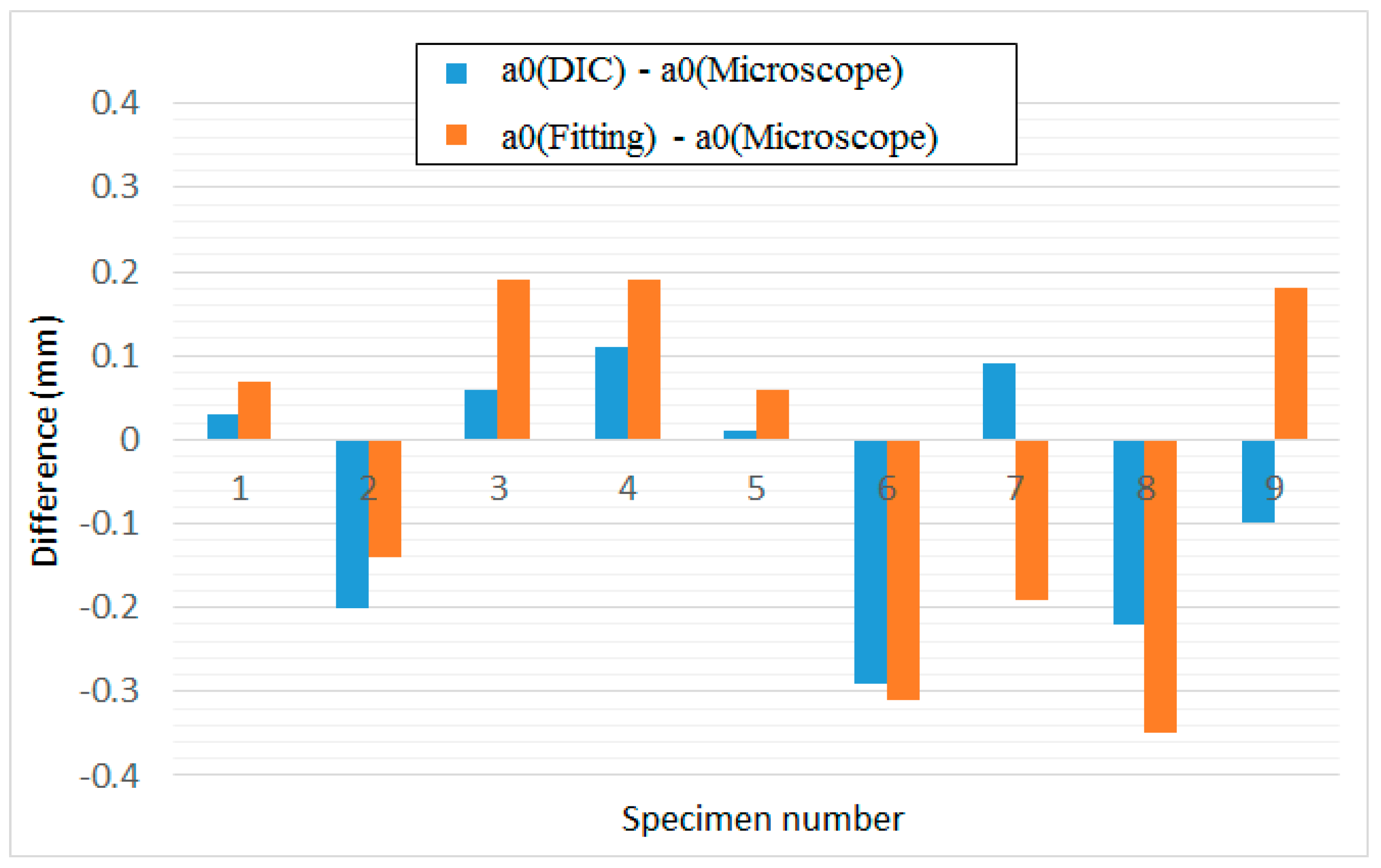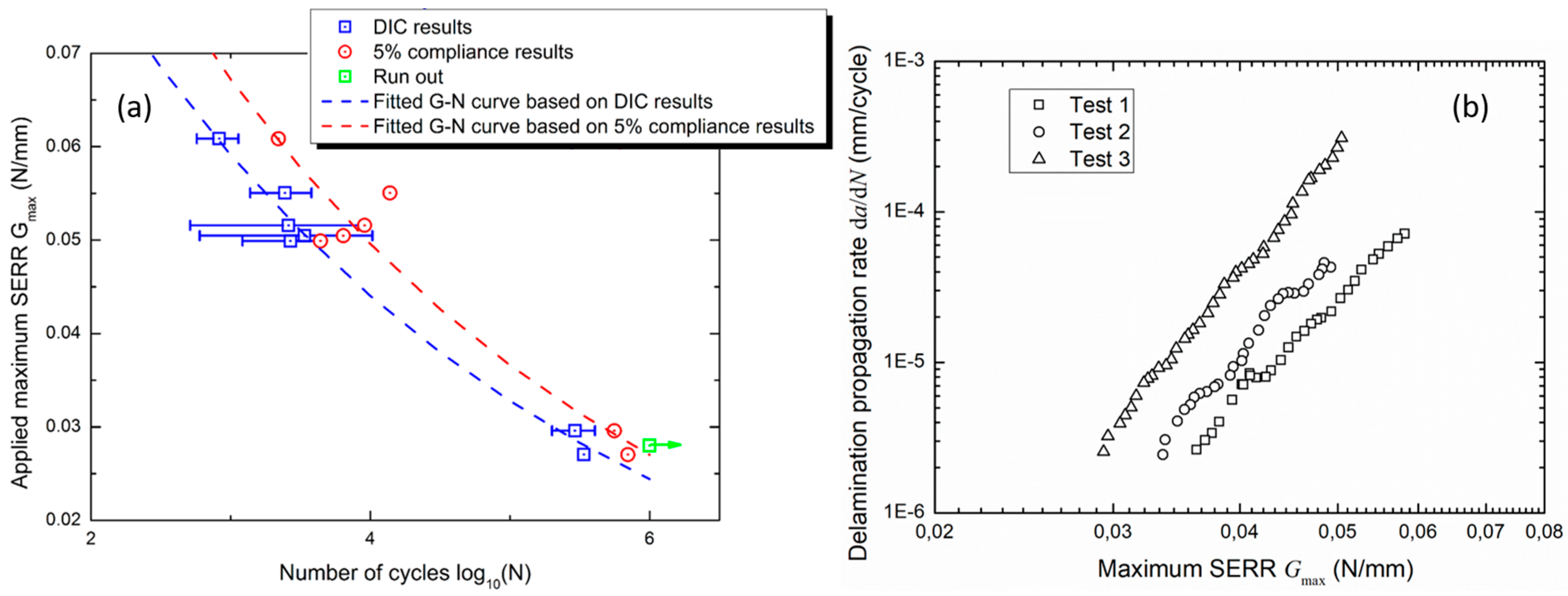Digital Image Correlation Measurements of Mode I Fatigue Delamination in Laminated Composites †
Abstract
:1. Introduction
2. Material and Methods
2.1. Material and Test Procedures
2.2. Crack Tip Detection with DIC
2.3. Determination of Fatigue Onset Life
2.4. Detection of Fatigue Delamination Propagation
3. Results and Discussion
4. Conclusions
Author Contributions
Acknowledgments
Conflicts of Interest
References
- McNeill, S.R.; Peters, W.H.; Sutton, M.A. Estimation of stress intensity factor by digital image correlation. Eng. Fract. Mech. 1987, 28, 101–112. [Google Scholar] [CrossRef]
- Lee, D.; Tippur, H.; Kirugulige, M. Experimental study of dynamic crack growth in unidirectional graphite/epoxy composites using digital image correlation method and high-speed photography. J. Compos. Mater. 2009, 43, 2081–108. [Google Scholar] [CrossRef]
- Mehdikhani, M.; Matveeva, A.; Aravand, M.A.; Wardle, B.L.; Lomov, S.V.; Gorbatikh, L. Strain mapping at the micro-scale in hierarchical polymer composites with aligned carbon nanotube grafted fibers. Compos. Sci. Technol. 2016, 137, 24–34. [Google Scholar] [CrossRef]
- Lomov, S.V.; Ivanov, D.S.; Verpoest, I.; Zako, M.; Kurashiki, T.; Nakai, H.; Molimard, J.; Vautrin, A. Full field strain measurements for validation of meso-FE analysis of textile composites. Compos. Part A 2008, 39, 1218–1231. [Google Scholar] [CrossRef]
- ASTM D6115-97(2011), Standard Test Method for Mode I Fatigue Delamination Growth Onset of Unidirectional Fiber-Reinforced Polymer Matrix Composites; ASTM International: West Conshohocken, PA, USA, 2011.
- Bak, B.L.V.; Sarrado, C.; Turon, A.; Costa, J. Delamination under fatigue loads in composite laminates: A review on the observed phenomenology and computational methods. Appl. Mech. Rev. 2014, 66, 060803. [Google Scholar] [CrossRef]
- ASTM E647-15e1, Standard Test Method for Measurement of Fatigue Crack Growth Rates; ASTM International: West Conshohocken, PA, USA, 2015.
- Stelzer, S.; Brunner, A.J.; Argüelles, A.; Murphy, N.; Pinter, G. Mode I delamination fatigue crack growth in unidirectional fibre reinforced composites: Development of a standardized test procedure. Compos. Sci. Technol. 2012, 72, 1102–1107. [Google Scholar] [CrossRef]
- Asp, L.E.; Sjogren, A.; Greenhalgh, E.S. Delamination growth and thresholds in a carbon/epoxy composite under fatigue loading. J. Compos. Technol. Res. 2001, 23, 55–68. [Google Scholar]



Publisher’s Note: MDPI stays neutral with regard to jurisdictional claims in published maps and institutional affiliations. |
© 2018 by the authors. Licensee MDPI, Basel, Switzerland. This article is an open access article distributed under the terms and conditions of the Creative Commons Attribution (CC BY) license (https://creativecommons.org/licenses/by/4.0/).
Share and Cite
Zhu, M.; Gorbatikh, L.; Fonteyn, S.; Pyl, L.; Hemelrijck, D.V.; Carrella-Payan, D.; Lomov, S.V. Digital Image Correlation Measurements of Mode I Fatigue Delamination in Laminated Composites. Proceedings 2018, 2, 430. https://doi.org/10.3390/ICEM18-05289
Zhu M, Gorbatikh L, Fonteyn S, Pyl L, Hemelrijck DV, Carrella-Payan D, Lomov SV. Digital Image Correlation Measurements of Mode I Fatigue Delamination in Laminated Composites. Proceedings. 2018; 2(8):430. https://doi.org/10.3390/ICEM18-05289
Chicago/Turabian StyleZhu, Man, Larissa Gorbatikh, Sander Fonteyn, Lincy Pyl, Danny Van Hemelrijck, Delphine Carrella-Payan, and Stepan V. Lomov. 2018. "Digital Image Correlation Measurements of Mode I Fatigue Delamination in Laminated Composites" Proceedings 2, no. 8: 430. https://doi.org/10.3390/ICEM18-05289



